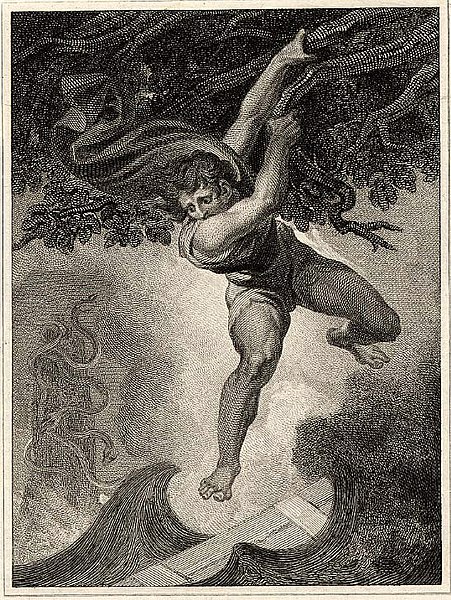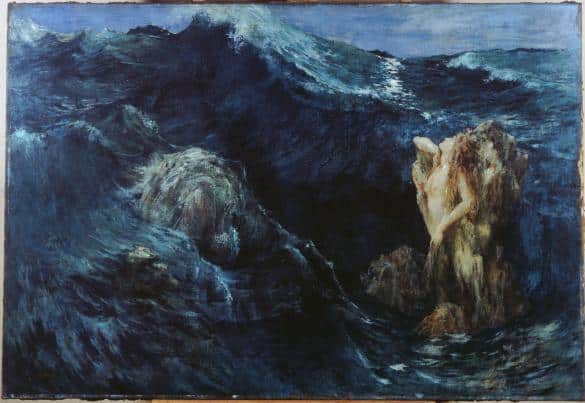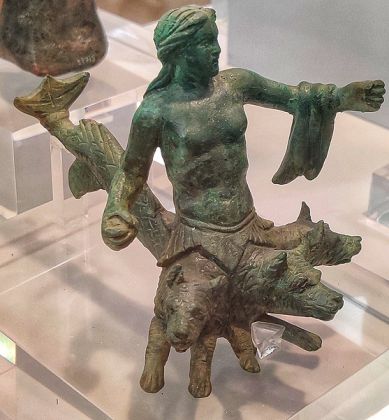Scylla, with her many heads and ravenous appetite, has long been among the most feared of all the marine monsters in Greek mythology. Nestled in the rocky shores opposite the whirlpool Charybdis, she has been the doom of many a sailor. As we set sail on this narrative journey, let’s delve into the depths of Scylla’s story, a creature whose very name evokes fear and awe.
Scylla Key Facts
| Origin | Transformed nymph |
| Creator | Cursed by Circe |
| Feared by | Sailors and heroes |
| Habitat | Strait of Messina |
| Distinctive Features | Twelve tentacle-like legs, six dog-headed necks |
| Associated with | Charybdis, Odysseus |
| Symbols | Sea, rocks, tentacles |
Name and Etymology
The name “Scylla” resonates with danger and unpredictability, much like the treacherous waters she inhabited. While the exact etymology remains a subject of debate, many believe it’s derived from the Greek word “skyllo,” which means “to rend” or “to tear apart,” aptly describing her penchant for snatching sailors from their ships.

In various tales and translations, Scylla is often referred to with terms that emphasize her monstrous nature and her role as a terror of the seas. Her name alone became synonymous with danger, a testament to her fearsome reputation in Greek mythology.
The Tragic Metamorphosis of Scylla
The story of Scylla’s transformation is not just a tale of physical change but also a profound exploration of the complexities of love, envy, and the consequences of unchecked emotions. Once, Scylla was a nymph of unparalleled beauty, a vision that captivated both gods and mortals. Her grace and allure were such that she became the object of affection for many, including the sea god Glaucus, The Tragic Sea God.
However, as is often the case in the intricate tapestry of Greek mythology, love was intertwined with jealousy. Glaucus, smitten by Scylla, sought the assistance of the enchantress Circe to win her heart. But instead of aiding Glaucus, The Enchantress Circe, of the island Aeaea herself became infatuated with him. When her advances were spurned in favor of Scylla, Circe’s love quickly turned to envy and spite.
Unable to bear the sting of rejection and driven by her burgeoning jealousy, Circe concocted a malevolent potion. She poured this venomous brew into the waters where Scylla bathed, forever altering her fate. The once-radiant nymph was transformed into a monstrous sea creature, her beauty replaced by twelve tentacle-like legs and six fearsome heads, each with a ravenous mouth filled with sharp teeth.
This tragic metamorphosis serves as a poignant reflection on the duality of love and jealousy, and the devastating effects of unchecked emotions. Scylla’s tale is a stark reminder of the fragile balance between passion and obsession, and how the line between love’s beauty and its potential for destruction can be perilously thin.
Odysseus and Scylla: A Perilous Passage

One of the most harrowing episodes in Homer’s “Odyssey” is the encounter between the hero Odysseus and the monstrous Scylla. This event is emblematic of the myriad challenges Odysseus faced during his ten-year voyage home from the Trojan War.
As Odysseus and his crew navigated the treacherous waters, they were confronted with a dire choice: to face the deadly whirlpool Charybdis, The Whirlpool Monster of Ancient Myth or to brave the wrath of Scylla. The strait was so narrow that avoiding one peril meant confronting the other. The enchantress Circe, with whom Odysseus had spent a year, had forewarned him of this impending danger. She advised him to sail swiftly past Scylla, for while the monster would undoubtedly snatch six of his men, the whirlpool had the power to sink his entire ship, taking all hands with it.
Heeding Circe’s counsel, Odysseus donned his armor but refrained from wielding his weapons, for Circe had cautioned that battling Scylla would be in vain. The monster was too swift, too powerful. As they sailed through the strait, Odysseus implored his crew to row with all their might. Yet, Scylla’s speed was unmatched. In a horrifying instant, she lunged from her rocky lair, seizing six of Odysseus’ men.
The sheer horror of the moment is palpable in Homer’s narration. Scylla’s victims were dashed against the rocks and consumed even as their comrades watched in helpless terror. The cries of the doomed men, as described by Homer, were the most heart-wrenching sounds Odysseus had ever heard, a poignant testament to the trials he endured on his long journey home.
This encounter with Scylla is not just a tale of horror but also a reflection on the choices one must make in life. The narrow strait, with Scylla on one side and Charybdis on the other, symbolizes the difficult decisions we often face, where avoiding one danger might lead us into the path of another.
Depiction And Characteristics

Scylla, with her tales of terror and might, has been depicted in myriad ways throughout history. Let’s explore some of the most iconic representations and characteristics of this sea monster.
Scylla’s appearance is a blend of horror and awe. With her twelve tentacle-like legs and six dog-headed necks, she’s a sight that spells doom for sailors. Each of her heads, with its sharp teeth, is a testament to her ravenous nature, ready to snatch any unsuspecting sailor.
Symbols often associated with Scylla include the sea, representing her domain, and the rocks, symbolizing the dangers she posed to those who ventured too close.
Nature and Behavior
Scylla’s nature is one of unpredictability and terror. Nestled in the rocky shores, she lay in wait for ships, ready to snatch and devour any sailor who ventured too close. Her behavior, while aggressive, is also a reflection of her tragic origin, a creature transformed and cursed to live as a monster.
Scylla Symbols or Associations
Scylla is often associated with the sea, representing her domain and the dangers she posed. Another frequent association is with Charybdis, the whirlpool monster. Together, they symbolize the dual dangers faced by sailors navigating the Strait of Messina, a perilous journey that tested the mettle of even the bravest mariners.
Representations Of Scylla In Art
Scylla, with her tales of terror and might, has inspired artists for generations. From intricate vase paintings to detailed sculptures, Scylla has been depicted in various forms, each capturing a different facet of her legend.

One of the most iconic representations is the painting showcasing her encounter with Odysseus. This piece, with its vivid colors and dramatic composition, captures the tension and drama of the moment, showcasing both Scylla’s might and the challenges faced by sailors of old.
Mentions in Ancient Texts
Scylla’s tales have been documented in various ancient texts, each offering a unique perspective on the sea monster. From detailed accounts of her encounters to mentions of her significance, these texts provide a glimpse into Scylla’s place in Greek mythology.
One of the most notable mentions is in Homer’s “Odyssey,” where Odysseus recounts his perilous encounter with Scylla. He writes, “As we sailed on, the roar of the sea grew louder, and we came to the narrow strait of Scylla and Charybdis. Here, Scylla snatched six of my men from the ship.”
Frequently Asked Questions
Scylla was transformed into a sea monster due to Circe’s jealousy and a potion that the sorceress poured into the sea where Scylla bathed.
Scylla dwelled in the Strait of Messina, opposite the whirlpool monster, Charybdis.
One of the most famous figures to encounter Scylla was the hero Odysseus during his perilous journey home.
Scylla is typically depicted with twelve tentacle-like legs and six dog-headed necks, symbolizing her monstrous nature.
Together, Scylla and Charybdis represent the dual perils faced by sailors navigating the Strait of Messina, often symbolizing a situation where avoiding one danger leads to another.
No, Scylla was once a beautiful nymph before her tragic transformation into a sea monster.
Featured Image Credit: Marie-Lan Nguyen, Public domain, via Wikimedia Commons
